Currently, you are located at: Home Cognitive Weather and Climate Where does the atmosphere end?
Where exactly does the atmosphere come to an end?
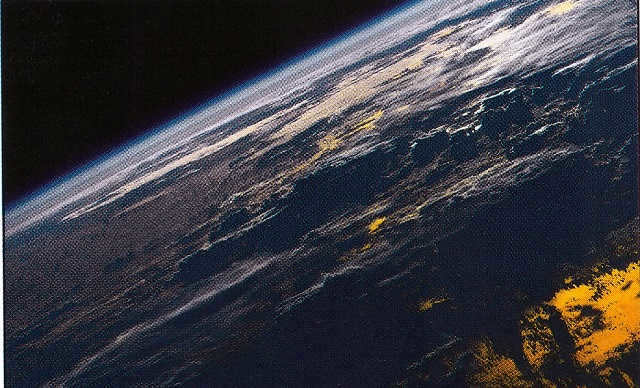
When observed from the vastness of outer space, the atmosphere presents itself as an ethereal shroud, delicately intertwined by the gravitational forces of our planet. Nevertheless, when observed from the vantage point of our planet’s surface, we perceive it extending unimaginably high and appearing a deep shade of blue as it seamlessly melds into the boundless expanse of space. Remarkably, the atmosphere lacks a definitive demarcation and spans several hundred kilometers in thickness.
The troposphere is the lowest layer of the atmosphere, and it has the highest density. As we move higher in altitude, the atmosphere becomes thinner. From the Earth’s surface to about 80 kilometers above, the air composition remains almost the same, with nitrogen and oxygen making up 99% of the air. Moving into the thermosphere, we find the ionosphere, which is where solar radiation causes the ionization of atmospheric gas. This means that atoms and molecules lose electrons and become electrically charged. As we go higher, solar X-rays and ultraviolet radiation break down large molecules, causing a decrease in the nitrogen and oxygen content. In the exosphere, which starts at an altitude of about 500 km, only hydrogen and helium atoms are present. The exosphere marks the boundary of the atmosphere, beyond which lies the magnetosphere. The magnetosphere is a vast region without air, held together by the Earth’s magnetic field.
When viewed from outer space, the planet’s atmosphere seems like a delicate blue shell, but in reality, it extends hundreds of kilometers in thickness.
During the day, charged particles in the ionosphere, known as plasma, ascend to the upper layers of the atmosphere. However, in the absence of solar energy at night, the plasma descends back into the atmosphere.
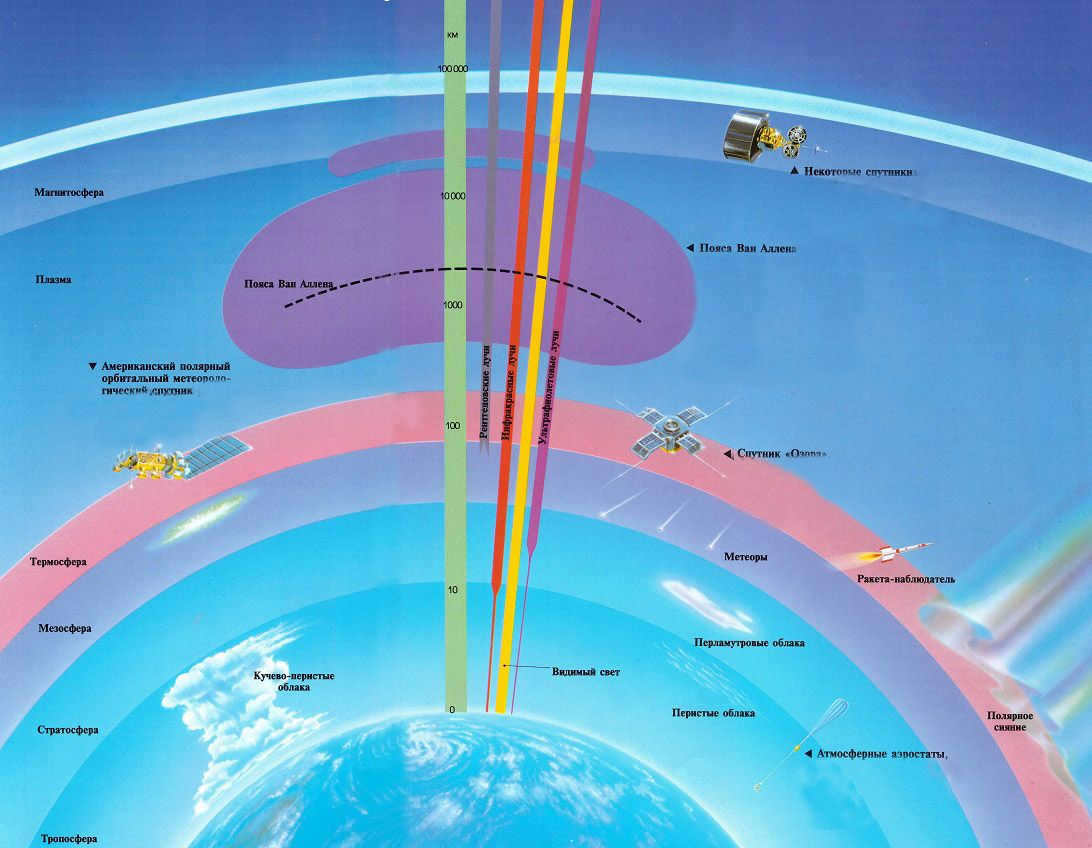
The Van Allen Belts are regions of high radiation encircling the Earth in the shape of doughnut rings, as depicted in this diagram. These belts contain energetic particles, possibly originating from cosmic rays and the solar wind.
The Ozora satellite orbits the mesosphere and magnetosphere at altitudes ranging from 300 to 1,000 kilometers.
Atmospheric balloons, also known as radiosondes, ascend to approximately 40 km, where they measure atmospheric parameters such as wind strength and pressure.
Certain satellites maintain a geostationary orbit around the Earth at a distance of 36,000 kilometers, remaining fixed above a specific point.
The U.S. Polar Orbiting Meteorological Satellite collects data on temperature, water vapor, and cloud conditions from an altitude of 850 kilometers.
Current location: Home Cognitive Weather and Climate Where does the atmosphere end?
Trending articles in this category:
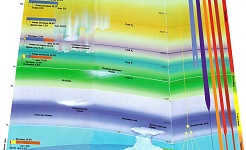
What are the components of the atmosphere?
The air surrounding the Earth does not have any apparent confines. Nevertheless, after conducting studies with rockets and balloons, scientists have determined that the air can be segmented into five distinct layers. These layers (arranged in order from the Earth’s surface) include…
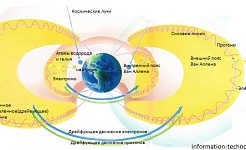
What are the Van Allen Belts?
The Van Allen Belts refer to a belt of radiation that was discovered 1000 kilometers above the Earth’s surface by the first American space satellite, Explorer 1, which was launched in 1958. This groundbreaking discovery confirmed the scientific value of space exploration and opened up new possibilities for further research. The radiation found in the Van Allen Belts is about 100 million times…
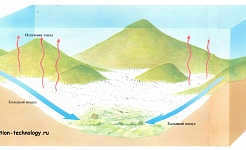
Formation of Fog
Fog is a type of cloud that forms close to the ground. It occurs when warm and moist air meets cooler air.
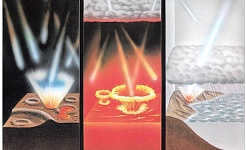
How did the atmosphere come into existence?
The process of atmosphere formation. In the present day, the Earth’s atmosphere is composed of a combination of gases, including 78% nitrogen, 21% oxygen, and trace amounts of other gases like carbon dioxide. However, when the planet initially formed, there was no oxygen present in the atmosphere – it consisted of…
It is essential for anyone who is literate to be aware not only that the planet is enveloped by an atmosphere consisting of a mixture of various gases, but also that there are distinct layers of the atmosphere situated at varying distances from the Earth’s surface.
When we look up at the sky, we are unable to perceive its intricate structure, its diverse composition, or any other hidden elements. However, it is the complex and diverse makeup of the atmospheric layer that creates the conditions necessary for life to thrive on this planet, allowing for the growth of vegetation and the existence of everything that has ever lived here.
Knowledge about this topic is typically acquired by individuals as early as the 6th grade in school, although some may not have reached this point yet, while others may have learned it so long ago that they have forgotten the details. Nevertheless, it is important for every educated person to have an understanding of what the world around them is made of, particularly the aspects that directly impact their own ability to live a normal life.
What are the names, altitudes, and roles of each layer in the Earth’s atmosphere? These questions will be addressed below.
The Composition of the Earth’s Atmosphere
When gazing at the sky, particularly on a clear day, one may find it arduous to fathom the intricate and layered structure of the atmosphere. The temperature varies significantly at different heights, and it is in these elevated regions where crucial processes occur, impacting the planet’s flora and fauna.
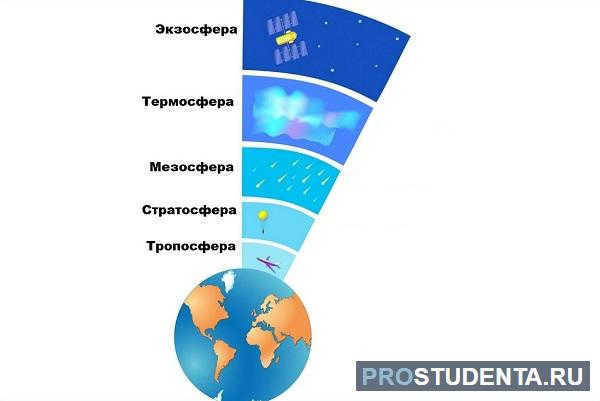
If it were not for the intricate makeup of the planet’s gaseous envelope, life would cease to exist and the possibility of its genesis would be nonexistent.
The ancient Greeks were the first to venture into the study of this realm, but their conclusions were limited by their lack of technological resources. They were unable to perceive the boundaries between different layers, measure their temperatures, analyze their component composition, and so on.
Primarily, it was the occurrence of weather phenomena that prompted the most innovative thinkers to recognize the complexity of the visible sky.
Scientists believe that the formation of the current gas envelope surrounding Earth occurred in three distinct phases. Initially, there existed a primary atmosphere consisting of hydrogen and helium that was captured from the outer space.
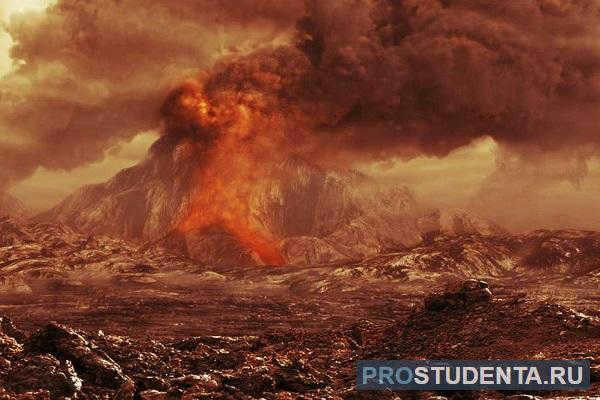
Subsequent volcanic activity led to the release of numerous particles into the atmosphere, giving rise to a secondary atmosphere. Once all the necessary chemical reactions and particle relaxation processes had occurred, the current atmospheric conditions were established.
Order and Characteristics of Atmospheric Layers from the Earth’s Surface
The composition and structure of the Earth’s gas envelope are intricate and varied. We will delve into it further, progressively ascending to the highest levels.
The Troposphere
Excluding the boundary layer, the troposphere represents the lowest atmospheric layer. It reaches an altitude of approximately 8 to 10 kilometers above the Earth’s surface in polar regions, 10 to 12 kilometers in temperate climates, and 16 to 18 kilometers in tropical areas.
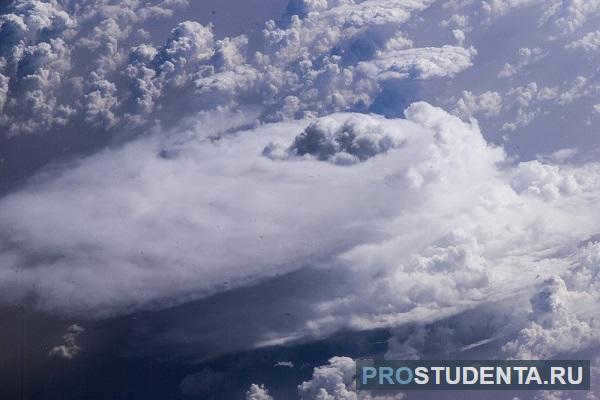
[warning.]Fascinating fact: The distance at which the atmosphere ends can vary depending on the season – it is slightly shorter during winter than in summer.[/warning].
The troposphere’s air contains the primary life-sustaining element for all living beings on our planet. It encompasses approximately 80% of the total atmospheric air, over 90% of water vapor, and serves as the birthplace for clouds, cyclones, and other atmospheric phenomena.
It is intriguing to observe the gradual temperature decrease as we ascend from the Earth’s surface. Scientists have calculated that for every 100 meters of elevation, the temperature drops by approximately 0.6-0.7 degrees.
Stratosphere
The stratosphere, which is around 45-50 kilometers in height, is the next crucial layer. At an altitude of 11 kilometers, the stratosphere begins, and at this point, negative temperatures dominate, dropping as low as -57 ° C.
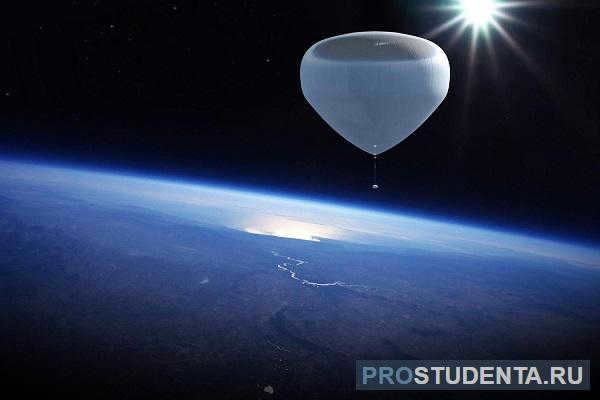
The ozone layer is located at a height of 20-25 kilometers and plays a crucial role for humans, animals, and plants. Its primary function is to intercept ultraviolet rays from the sun and minimize their harmful impact on flora and fauna.
Interestingly, the stratosphere not only absorbs radiation from the sun but also from other stars and outer space. The energy received from these particles results in the ionization of molecules and atoms, leading to the formation of various chemical compounds.
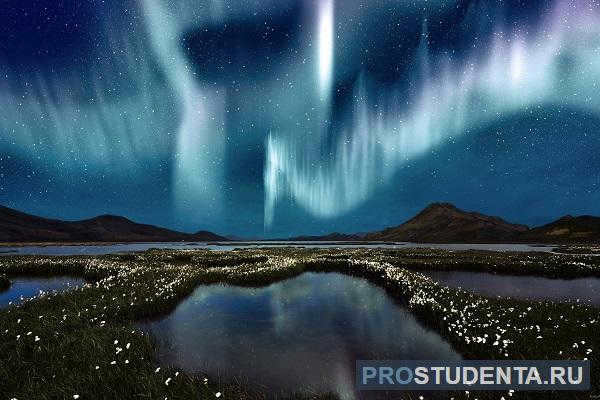
This leads to a well-known and vibrant phenomenon known as the aurora borealis.
Mesosphere
The mesosphere begins at around 50 and extends up to approximately 90 kilometers. The temperature gradient, or difference in temperature with altitude, is not as significant as in the lower layers. At the upper boundaries of this layer, the temperature is approximately -80°C. This region mainly consists of 80% nitrogen and 20% oxygen.
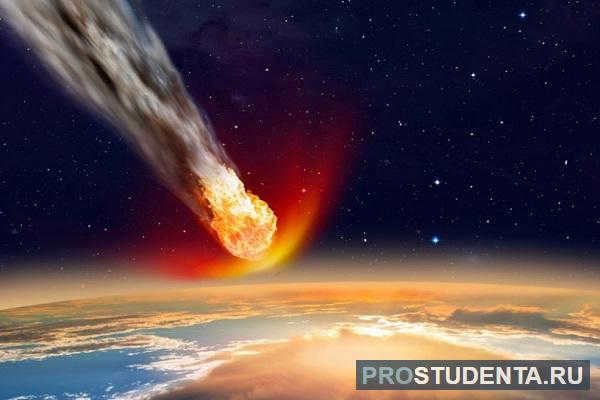
It should be noted that the mesosphere acts as a no-fly zone for any aerial devices. Airplanes are unable to navigate through this region due to the thinness of the atmosphere, while satellites do not operate at such a low altitude as the air density is too high for them.
Additionally, the mesosphere possesses another intriguing attribute. It serves as the fiery graveyard for meteorites that collide with the planet. Exploring these distant layers from Earth requires the use of specialized rockets, but the efficiency of this process is currently limited, thus leaving much room for improvement in the study of this region.
Thermosphere
Right after the layer mentioned above, we have the thermosphere, extending up to 800 kilometers in height. In a sense, it’s like being in outer space. In this region, there is a high exposure to cosmic radiation, radiation, and solar radiation.
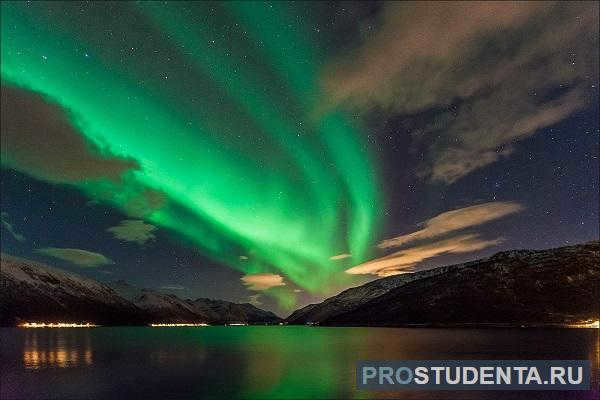
The aurora borealis is a magnificent and captivating natural phenomenon that is brought about by all of these factors.
The thermosphere’s lowest layer is heated to a temperature of approximately 200 K or higher. This occurs as a result of basic interactions between atoms and molecules, including recombination and radiation.
Conversely, the upper layers experience heating due to magnetic storms and the presence of electric currents. The temperature within this layer is not consistent and can vary greatly.

The thermosphere is where most artificial satellites, ballistic bodies, manned stations, etc., are located. Additionally, this is where tests of various weapons and rockets are conducted.
Exosphere
The exosphere, also known as the scattering sphere, is the highest level of our atmosphere and serves as the boundary to interplanetary space. It starts at an altitude of approximately 800-1000 kilometers.

Dense layers are left behind and at this point, the atmosphere becomes incredibly thin. Any particles that manage to enter from the outside are simply carried away into space due to the weak gravitational force.
This boundary is located at an altitude of approximately 3,000 to 3,500 kilometers. In this region, there are hardly any particles present. This area is known as the near-space vacuum. Here, plasma, often fully ionized, is the dominant form of matter rather than individual particles.
The Significance of Earth’s Atmosphere in Sustaining Life
Here is an illustration depicting the primary layers that constitute the structure of our planet’s atmosphere. While there may be additional sections in a more comprehensive diagram, they hold a lesser degree of importance.

It is worth noting that the atmosphere plays a vital role in supporting life on Earth. The abundance of ozone in the stratosphere allows plants and animals to avoid the harmful effects of radiation from space.
Furthermore, it is within the atmosphere that weather patterns form, atmospheric phenomena occur, and cyclones and winds originate and dissipate, ultimately influencing human well-being and the overall health of all organisms and plants.
The closest layer, known as the troposphere, provides us with the ability to breathe and oxygenates all living beings, sustaining their lives. Even slight alterations in the structure and composition of the atmosphere can have significant detrimental effects on all living organisms.
Tell me, what knowledge do you possess regarding the vast expanse of the sky? Allow us to delve into the concept of the aerial ocean, in which you and I reside, hidden beneath its depths, only occasionally emerging onto its outermost layer. However, this notion is not entirely undisputed! In fact, there are claims asserting that it extends all the way to the moon.

Ascending to the Theodor von Karman line. The initial 100 kilometers
5-5,500 kilometers – Be cautious, the physiological region of the atmosphere concludes!
At an elevation of 5,000 meters, both the air pressure and oxygen concentration decrease by fifty percent. Surviving in such conditions for more than a couple of hours is impossible without thorough and lengthy acclimatization.
However, just below the “ceiling” of this threshold, in the Andes, lies the highest city in the world – La Rinconada (Peru), situated at an altitude of 5,100 meters.
The lack of oxygen is adequately “compensated” by another chemical element – gold. The gold mines attract a significant number of people to this area. In 2012, the city’s population reached approximately 50,000 individuals.
To provide context: 99% of the global population resides below an elevation of 2 kilometers.
9 kilometers – “inhale deeply”.
At 9 thousand meters, the capability to momentarily breathe atmospheric air becomes limited. The peak of Mount Everest (also known as Jomolungma) in the Himalayas falls just shy of this measurement, standing at an elevation of 8,848 meters above sea level.
The journey to Jomolungma requires approximately 2 months, with about a month dedicated to acclimatization.
Humans are unable to ascend beyond that point on foot. But can birds?
The upper echelon of birds is 10-11 kilometers.
What is the maximum altitude that birds can reach? And what causes them to climb to such great heights? The answer lies in the Himalayas, the tallest mountain range on Earth. Many birds migrate through these mountains, and it’s no surprise that they have to fly over them at high altitudes.
One example is the mountain geese, also known as Anser indicus, which inhabit high altitude lakes across Central Asia. They migrate south through the Himalayas during the winter. These birds are among the highest flyers, with a recorded flight altitude of 10,175 meters. They can traverse the Himalayas in just 8 hours. Coming in second place is the gray crane, which has been recorded flying over the Himalayas at an altitude of 10,050 meters.
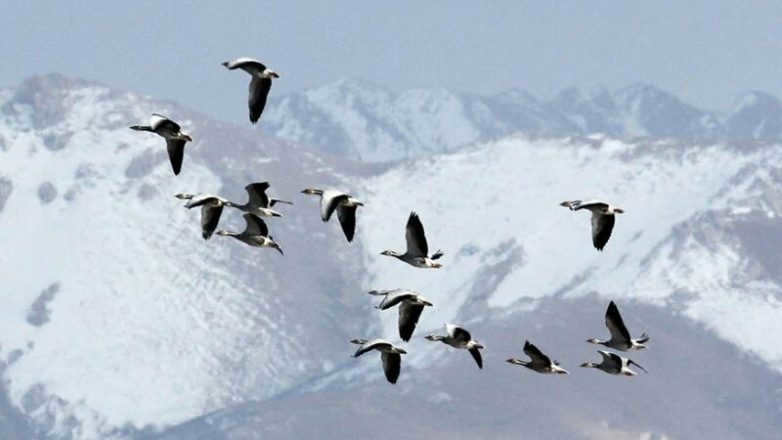
The African vulture, also known as Rüppel’s vulture, inhabits the savannahs in the northern region (south of the Sahara) and the eastern part of Africa. There was a documented incident in 1973 where this bird collided with an aircraft at an astonishing altitude of 11,277 meters. Nevertheless, the reason behind the vulture reaching such great heights remains unclear.
10-12 kilometers – “above the weather”.
The troposphere, which is the layer of the atmosphere responsible for weather, ends at an altitude of 10-12 kilometers, marking the beginning of the stratosphere. This transition is known as the tropopause.
The significance of distinguishing the troposphere as a separate layer lies in the fact that almost all weather phenomena occur within it, with only a small portion extending into the stratosphere (up to 50 kilometers). Additionally, the tropopause serves as the upper limit for the formation of regular clouds.
All of this lies beneath us, and we still have a peak to ascend….
The ceiling for subsonic passenger airliners is 12 km
To clarify: supersonic passenger planes like the Tu-144 and Concorde differ from regular Airbus and Boeing planes not only in their speed of flight, but also in their altitude.
Regular (subsonic) passenger planes fly at altitudes of 9-12 km. The Tu-144 flew at an altitude of 16000-17000 meters at a speed of 2000 km/h. Its practical ceiling (the maximum altitude the aircraft can actually reach) with the RD-36-51A engine was 20 kilometers.
20 kilometers – “near space” commences
An optimal location for space tourism. The vista from the porthole is akin to that of being in orbit, although satellites have not yet traversed this area. The sky ranges from a deep purple to a black-purple hue (at higher altitudes). The horizon exhibits a distinctive curvature.
20-22 kilometers represents the outer boundary of the biosphere.
The ozone layer is located at a distance of 20-25 km.
Just in case someone is not aware, ozone is a gas composed of three oxygen atoms. The oxygen we breathe consists of only two atoms. The three-atom molecules are formed when ordinary two-atom oxygen is exposed to ultraviolet radiation from the Sun.
About 500-600 million years ago, the ozone layer emerged in the atmosphere as a result of the accumulation of sufficient oxygen through photosynthesis.
25-26 km is the highest altitude at which current jet aircraft can operate
This is also the maximum altitude for military jet planes. The Lockheed SR-71 “Blackbird”, a supersonic reconnaissance aircraft used by the U.S. Air Force, has a practical ceiling of 25,910 meters.
However, this doesn’t imply that airplanes cannot fly at higher altitudes. How is that possible? Let’s continue reading.
The American company World View had a vision to transport tourists to approximately 30 kilometers above the Earth’s surface. However, rather than utilizing a traditional rocket or airplane, they proposed a unique method involving a capsule tethered to a colossal balloon, comparable in size to a soccer field. This extraordinary journey would span a duration of 6 hours, with 4 hours spent at the designated altitude. It is important to note that at this height, the environment closely resembles outer space, although weightlessness is not experienced. The concept is truly remarkable, yet it has not yet come to fruition.
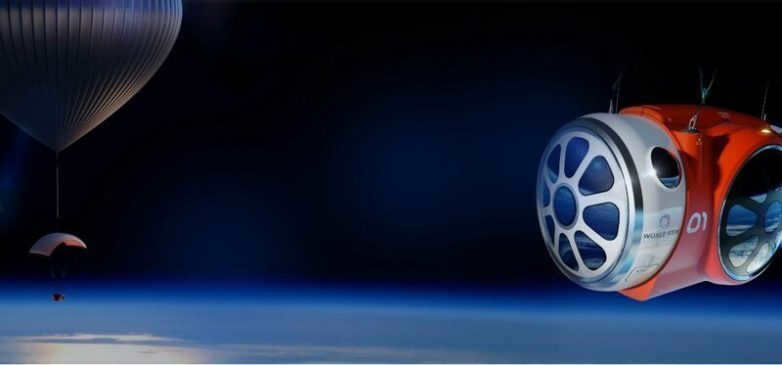
34.4 kilometers – our destination is Mars.
Just a jest, but with a hint of truth. This elevation corresponds to the average atmospheric pressure near the Martian surface. NASA tests its parachute landing systems for the Red Planet at this altitude.
Although the “Supersonic Inflatable Aerodynamic Decelerators” (Supersonic Inflatable Aerodynamic Decelerators) don’t quite resemble the parachutes we’re familiar with. They’re more akin to flying saucers. The inflatable decelerator was hoisted by a balloon to a height of 36 km, and then propelled to a height of 55 km using rocket engines. It was subsequently released.
37 km – the upper limit for airplanes
Aside from the operational ceiling (as mentioned above), there is also a dynamic limit. To reach this limit, the aircraft must accelerate to its maximum speed and then perform a maneuver to gain altitude (known as a slide).
The record for aircraft altitude was achieved on August 21, 1977 by test pilot Alexander Fedotov in a MiG-25, reaching a height of 37,650 meters.
41 kilometers – why not go skydiving?
41,425 meters is the current height record for a solo stratospheric balloon flight and also the record for the highest skydive. On October 24, 2014, Alan Eustace, who was then a high-ranking executive at Google, ascended to the stratosphere while tethered to a balloon. He then voluntarily jumped from that height, wearing a spacesuit.
Interestingly, this incredible feat took place in the city of Roswell. It has been quite some time since anything unexpected has fallen from the sky in that area.
50-55 kilometers, that’s where the stratosphere ends. It’s just a rocket ride away
Next comes the mesosphere. The transition between the stratosphere and the mesosphere is known as the stratopause. The mesosphere is famous for its “subspace” silver clouds at 75-85 kilometers above Earth’s surface. Yes, we’re getting closer to space.

Furthermore, the mesosphere serves as a sort of “interrogation chamber” for extraterrestrial beings. It acts as a barrier, causing most “celestial rocks” that are unable to overcome Earth’s gravity to disintegrate. Observing a meteor in the night sky is akin to witnessing the mesosphere’s purifying flames.
The atmosphere at this altitude is too sparse for airplanes or balloons to navigate, yet too dense for artificial satellites to traverse. To investigate this atmospheric layer, researchers rely on suborbital weather rockets. On September 20, 2013, the Japanese meteosonde BS13-08 reached the mesosphere at a height of 53.7 km, setting a new record for unmanned gas balloon flight.

The United States marks the beginning of space at 80 km
Essentially, the demarcation between space and the atmosphere is a matter of convention. The entire world still recognizes the 100 km threshold. However, the U.S. Air Force designates the boundary between atmosphere and space at 50 miles (80.45 km) above sea level. Pilots who surpass this altitude are granted the title of astronaut. NASA follows the same protocol.
Space Begins Above the Rest of the World at 100 km
This is the internationally recognized boundary that marks the division between the Earth’s atmosphere and outer space. It also serves as the boundary between aeronautics and astronautics.
Scientists believe that at this altitude, the atmosphere becomes so thin that conventional aviation is no longer feasible. The speed required to generate enough lift surpasses the threshold for entering space. To reach even higher altitudes, spacecraft must be utilized.
This boundary, known as the Karman Line, was calculated by Theodore von Karman, a Hungarian-American scientist, and is named in his honor.
The planet we live on is composed of three distinct elements: land, water, and air. Each of these components possesses its own distinctive qualities and captivating characteristics. In this discussion, however, we will focus solely on the latter. What exactly is the atmosphere? How did it come into existence? What is its composition and how is it segmented? These inquiries are undeniably intriguing.
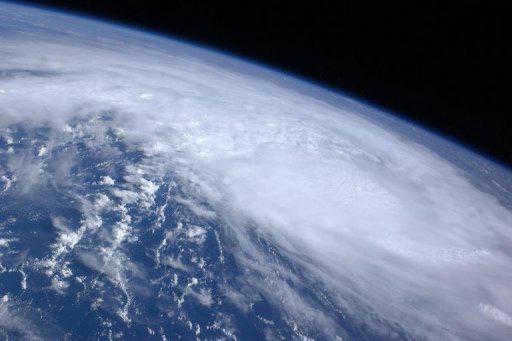
The term “atmosphere” is derived from two Greek words, which when translated into Russian mean “vapor” and “sphere”. When looking at the precise definition, one can read the following: “The atmosphere is the air envelope surrounding planet Earth, which extends into outer space.” It developed concurrently with the geological and geochemical processes that occurred on the planet. Even today, all biological processes rely on it. Without an atmosphere, the planet would resemble a lifeless desert similar to the Moon.
The question of what constitutes the atmosphere and which elements are present within it has intrigued individuals for a long time. The primary constituents of this protective layer were already identified in 1774 by Antoine Lavoisier. He discovered that the atmosphere primarily consists of nitrogen and oxygen. As time has progressed, the composition of the atmosphere has become more comprehensively understood, revealing the presence of numerous other gases, as well as water and dust.
Let us delve deeper into the composition of the Earth’s atmosphere near its surface. The most abundant gas is nitrogen, comprising slightly over 78 percent of the total. Despite its large quantity, nitrogen is relatively inert within the air.
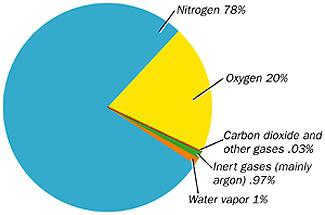
Oxygen, the following most plentiful and highly significant element, constitutes about 21 percent of the atmosphere and is exceptionally reactive. Its primary purpose is to oxidize deceased organic material, causing it to decompose through this reaction.
Gases with Minimal Presence but Great Significance
Argon is the third gas that comprises the atmosphere, albeit in a small quantity, less than one percent. Following it are carbon dioxide, neon, helium, methane, krypton, hydrogen, xenon, ozone, and even ammonia. However, these gases are present in such minuscule amounts that their percentage is measured in hundredths, thousandths, and millionths. Among them, only carbon dioxide holds a significant role as it serves as the building material essential for photosynthesis in plants. Additionally, it plays a crucial role in blocking radiation and absorbing some of the sun’s heat.
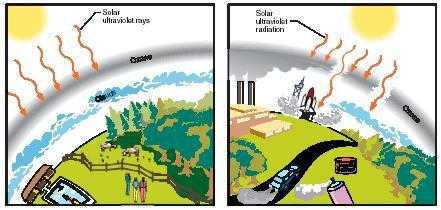
Ozone, a small yet crucial gas, serves the purpose of trapping ultraviolet radiation emitted by the sun. This unique characteristic ensures the safety and protection of all living organisms on the planet. Conversely, the presence of ozone also impacts the temperature of the stratosphere, as it absorbs the aforementioned radiation and subsequently heats the air.
The atmosphere’s consistent quantitative composition is upheld through continuous mixing. Its layers undergo both horizontal and vertical movement, resulting in an ample supply of oxygen and a balanced distribution of carbon dioxide across the globe.
What other components are present in the atmosphere?
It should be pointed out that there are also vapor and dust particles present in the air. The latter is made up of pollen and soil particles, and in urban areas, it is mixed with solid emissions from vehicle exhaust.
However, the atmosphere also contains a significant amount of water. Under specific conditions, this water condenses and forms clouds and fog. These two phenomena are essentially the same, except that clouds form at higher altitudes above the Earth’s surface, while fog moves across it. Clouds come in various shapes, which depend on their altitude.
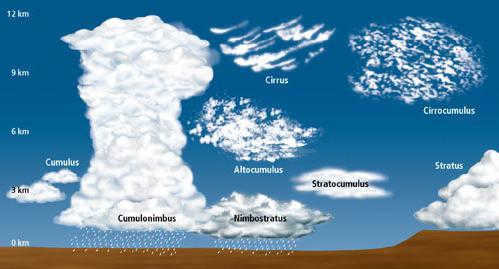
What are the different layers of the atmosphere?
The layers of the atmosphere are distinct and serve specific purposes, although it is challenging to determine the exact altitude at which each layer begins and ends due to varying temperatures. This division is approximate and subjective.
The lowest layer, known as the troposphere, expands from 8 to 18 km as one moves from the poles to the equator. It is the warmest part of the atmosphere, as it is heated by the Earth’s surface. The troposphere contains a significant amount of water vapor, leading to the formation of clouds, precipitation, thunderstorms, and winds.
The stratosphere, which is approximately 40 kilometers thick, is the next layer of the atmosphere. When entering this region, an observer would notice that the color of the sky has changed to purple. This phenomenon occurs because of the minimal scattering of sunlight caused by the low density of the substances present. The stratosphere serves as the flight path for jet airplanes, as it offers vast open spaces with minimal cloud cover. Additionally, within the stratosphere exists a layer abundant in ozone.
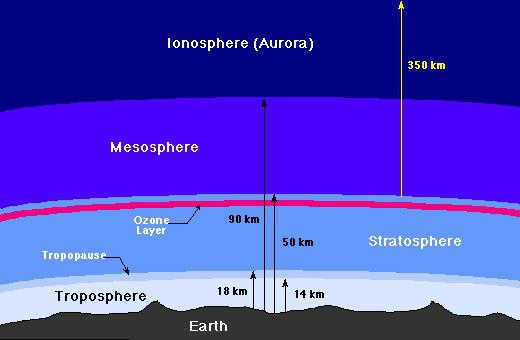
Next comes the stratopause and then the mesosphere. The mesosphere has a thickness of approximately 30 kilometers. It is distinguished by a significant reduction in the density and temperature of the air. To the observer, the sky appears black in this layer. Even during the daytime, stars can be observed here.
Layers with Minimal Air Content
The next layer in the atmospheric structure is known as the thermosphere, which happens to be the thickest layer, stretching up to 400 km. One notable feature of this layer is its extremely high temperature, which can soar up to 1700 °C.
The final two layers are often grouped together and referred to as the ionosphere. This is because they both involve reactions that result in the release of ions. These specific layers are responsible for the mesmerizing natural phenomenon known as the aurora borealis, or the northern lights.
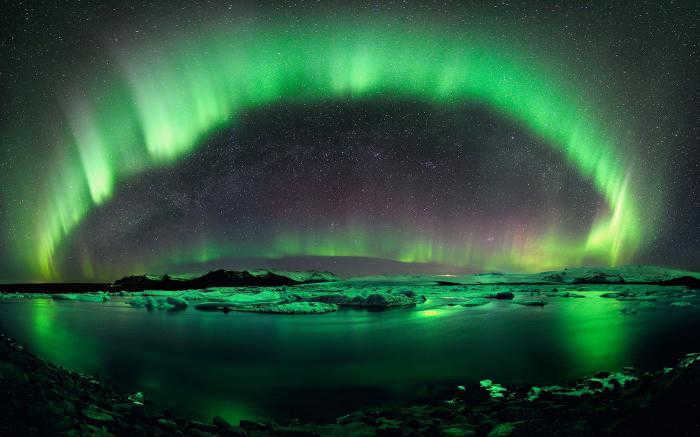
The exosphere is the outer shell of the atmosphere, extending 50 kilometers from Earth. It is in this layer that air particles disperse into space, making it an ideal location for weather satellites to travel.
At the edge of the exosphere lies the magnetosphere, which serves as a protective shield for the majority of the Earth’s artificial satellites.
With these explanations, any doubts regarding the importance of the atmosphere should be easily dispelled, as its various layers serve crucial functions for our planet and its technological infrastructure.
The Significance of the Earth’s Atmosphere
One of the primary purposes of the Earth’s atmosphere is to safeguard the planet’s surface by preventing overheating during daylight hours and excessive cooling during the night. Another crucial role of this protective layer, which is universally acknowledged, is to supply oxygen to all living organisms. Without it, life would be impossible.
The majority of meteoroids disintegrate in the upper layers of the atmosphere before reaching the Earth’s surface. This gives people the opportunity to witness these luminous displays and often mistake them for shooting stars. Without the atmosphere, the Earth’s surface would be covered in craters. Additionally, the atmosphere provides protection against harmful solar radiation, as previously mentioned.
What impact does human activity have on the atmosphere?
Human activity has a highly detrimental effect on the atmosphere. This is primarily driven by the increasing activities of individuals. The majority of negative impacts can be attributed to industrial processes and transportation. Interestingly, cars alone are responsible for emitting nearly 60% of all pollutants that enter the various layers of the atmosphere. The remaining 40% is divided among energy production, industrial activities, and waste management industries.
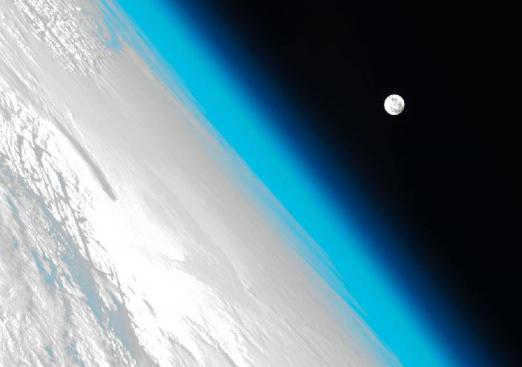
The roster of harmful substances that replenish the composition of the air on a daily basis is extensive. The atmosphere is impacted by a variety of pollutants such as nitrogen, sulfur, carbon, tin, soot, and a potent carcinogen known as benzopyrene, which is a leading cause of skin cancer.
The industrial sector is accountable for the release of several chemical elements into the atmosphere including sulfur dioxide, hydrocarbon, hydrogen sulfide, ammonia, phenol, chlorine, and fluorine. If this trend persists, the answers to the questions “What is the atmosphere?” and “What is it composed of?” will undergo significant changes.
The stratosphere is an upper region of our planet’s atmospheric layer, beginning approximately 11 kilometers above the Earth’s surface. This region is no longer accessible to passenger aircraft and is seldom characterized by the presence of clouds. Within the stratosphere lies the Earth’s ozone layer, a delicate barrier that shields the planet from harmful ultraviolet radiation.
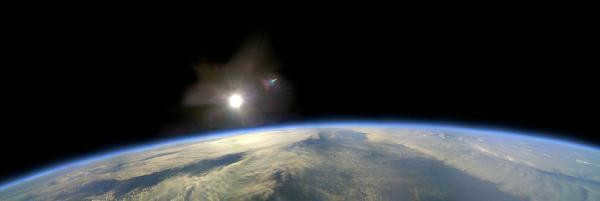
The Earth’s atmosphere is a gas shell that surrounds the planet and is in close proximity to both the hydrosphere and the Earth’s crust. Its inner surface is connected to these two spheres, while its outer boundary gradually transitions into outer space. The composition of the atmosphere consists of various gases such as nitrogen, oxygen, argon, carbon dioxide, and others. Additionally, there are impurities present in the form of dust, water droplets, ice crystals, and combustion byproducts. The main elements of the air envelope, namely nitrogen, oxygen, and argon, maintain a constant ratio. However, the levels of carbon dioxide and water in the atmosphere often fluctuate.
Layers of the gas envelope
The gas envelope surrounding the planet is divided into various distinct layers, each with its own unique composition:
- The boundary layer is the layer directly adjacent to the planet’s surface and extends up to a height of 1-2 km.
- The troposphere is the second layer, with its outer boundary located at an average height of 11 km. This layer contains a significant amount of water vapor, which leads to cloud formation and the occurrence of cyclones and anticyclones. Additionally, the temperature increases as the height within this layer increases.
Fluctuations in Stratospheric Temperature
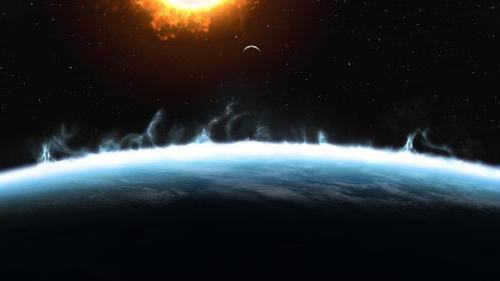
Therefore, the stratosphere is the section of the Earth’s gaseous envelope that comes after the troposphere. At this point, the temperature of the air, which remains constant throughout the tropopause, starts to vary. The stratosphere extends to approximately 40 km in height, with its lower boundary situated 11 km above sea level. From this point, the temperature experiences minor changes. At an altitude of 25 km, the rate of heating gradually begins to increase. By the time it reaches 40 km above sea level, the temperature increases from -56.5º to +0.8ºC. Beyond this point, it remains close to zero degrees until reaching an altitude of 50-55 kilometers. The region between 40 and 55 kilometers is referred to as the stratopause because the temperature remains constant within this zone. It serves as the transitional area between the stratosphere and the mesosphere.
The stratosphere of the Earth holds approximately 20% of the total mass of the atmosphere. The air in this region is so thin that it is impossible for a person to stay without a specialized spacesuit. This fact is one of the reasons why flights into the stratosphere have only recently been made possible.
Another characteristic of the gaseous envelope of the planet at an altitude of 11-50 km is the extremely low amount of water vapor. As a result, clouds rarely form in the stratosphere. There simply isn’t enough material for them to form. However, on rare occasions, pearlescent clouds can be observed adorning the stratosphere (see photo below) at an elevation of 20-30 km above sea level. These delicate, luminous formations can be seen after sunset or before sunrise. The shape of pearlescent clouds resembles that of fluffy or cumulus clouds.

Earth’s stratospheric ozone layer
The primary characteristic that sets the stratosphere apart is its high concentration of ozone throughout the entire atmosphere. This ozone layer is created by sunlight and serves as a protective shield for all life on Earth, shielding them from harmful radiation. Situated at an altitude of 20-25 km above sea level, the Earth’s ozone layer is primarily located within the stratosphere. While O3 molecules are dispersed throughout the stratosphere and can even be found near the planet’s surface, their highest concentration is found at this level.
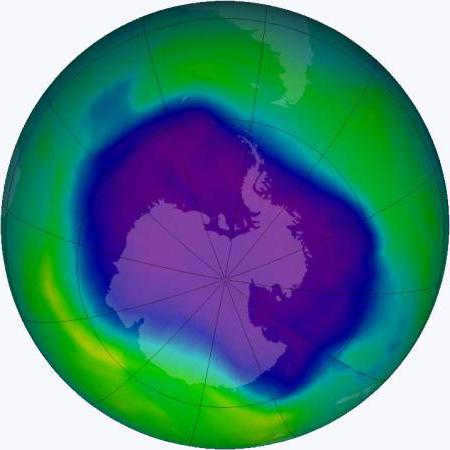
It is worth mentioning that the Earth’s ozone layer has a thickness of only 3-4 mm. This would be the measurement if the particles of this gas were placed under normal pressure conditions, such as near the planet’s surface. Ozone is created when an oxygen molecule decomposes into two atoms under the influence of ultraviolet light. One of these atoms combines with a “complete” molecule, resulting in the formation of ozone – O3.
A perilous guardian.
Ozone molecules serve as a shield by absorbing ultraviolet radiation with wavelengths shorter than 0.1-0.2 microns. This crucial role prevents harmful solar radiation from reaching the Earth, safeguarding living organisms.
Ozone is transported closer to the Earth’s surface through wind currents and is also generated during thunderstorms, photocopying processes, or X-ray exposure. Interestingly, high concentrations of ozone can be detrimental to human health. It is produced under sunlight in heavily polluted areas, posing a risk to life when exposed to the so-called ozone smog. This bluish gas has the potential to damage the lungs and disrupt normal plant development.
The Ozone Layer’s Demise
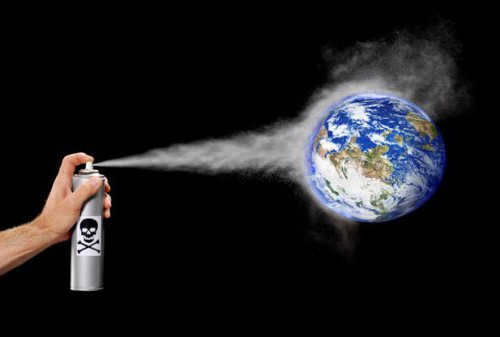
The issue of ozone depletion became a topic of active discussion within the scientific community around the 1970s. It is now widely acknowledged that atmospheric pollution, industrial utilization of freons and other compounds, deforestation, space rocket launches, and high-altitude aviation contribute to the destruction of the protective ozone layer. In order to combat this problem, the international community has implemented various agreements aimed at reducing the production of harmful substances. One of the major focuses has been on the reduction of freon usage in the production of aerosols, refrigeration units, fire extinguishers, disposable tableware, and other applications.
Exploring the Stratosphere
The exploration of the stratosphere commenced in the 1930s. In the present day, both military and supersonic commercial airplanes are capable of reaching altitudes of 20 km. Meteosondes, on the other hand, can ascend to a height of 40 km above sea level. The highest altitude ever achieved by an unmanned balloon is an impressive 51.8 km.

Adventurers who are passionate about extreme sports are steadily conquering this particular portion of the Earth’s atmosphere. Back in 2012, an Austrian skydiver named Felix Baumgartner took a leap from the stratosphere at a staggering altitude of nearly 39 kilometers. Not only did he successfully surpass the speed of sound during his descent, but he also managed to touch down safely. However, Baumgartner’s impressive record was later surpassed by Alan Eustace, the vice president of Google, who accomplished a similar feat by soaring through the stratosphere for 15 minutes and reaching the blistering speed of 40 kilometers per hour.





